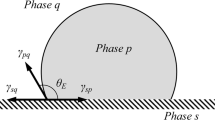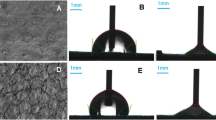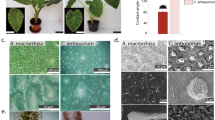Abstract
THE large values given by Fogg1 for the contact angles of water with leaves suggest that these are apparent rather than true contact angles. Adam2 and Wenzel3 have shown that rough surfaces give an apparent contact angle which is greater than the true contact angle for the smooth material of the surface when the true contact angle is greater than 90°. We have recently extended this theory to porous surfaces4, and to surfaces so rough that much air is entrapped at the interface between the water and the solid; large apparent contact angles are then possible when the true contact angle is even less than 90°. The apparent contact angle is given by where θD is the apparent or observed contact angle, θ is the true angle, f1 is the area of solid – water contact and f2 is the area of air – water contact per unit superficial area of the interface.
This is a preview of subscription content, access via your institution
Access options
Subscribe to this journal
Receive 51 print issues and online access
$199.00 per year
only $3.90 per issue
Buy this article
- Purchase on Springer Link
- Instant access to full article PDF
Prices may be subject to local taxes which are calculated during checkout
Similar content being viewed by others
References
Fogg, Nature, 154, 515 (1944).
Adam, "Physics and Chemistry of Surfaces",186 (3rd ed., Oxford, 1941).
Wenzel, Ind. Eng. Chem., 28, 988 (1936).
Cassie and Baxter, Trans. Farad. Soc., in the press.
Author information
Authors and Affiliations
Rights and permissions
About this article
Cite this article
CASSIE, A., BAXTER, S. Large Contact Angles of Plant and Animal Surfaces. Nature 155, 21–22 (1945). https://doi.org/10.1038/155021a0
Issue Date:
DOI: https://doi.org/10.1038/155021a0
This article is cited by
-
Droplet attraction and coalescence mechanism on textured oil-impregnated surfaces
Nature Communications (2023)
-
Deposition of ultra-thin coatings by a nature-inspired Spray-on-Screen technology
Communications Engineering (2023)
-
Synthetic brochosomes: design, synthesis, and applications
Nano Research (2023)
-
Magnetic Field-Driven and Photocured Rapid Shaping of Carbonyl Iron Particles in the Coating to Achieve Superhydrophobic Fabric
Fibers and Polymers (2023)
-
Controlled Wettability of Polymers via Environmental Crazing
Chinese Journal of Polymer Science (2022)
Comments
By submitting a comment you agree to abide by our Terms and Community Guidelines. If you find something abusive or that does not comply with our terms or guidelines please flag it as inappropriate.



